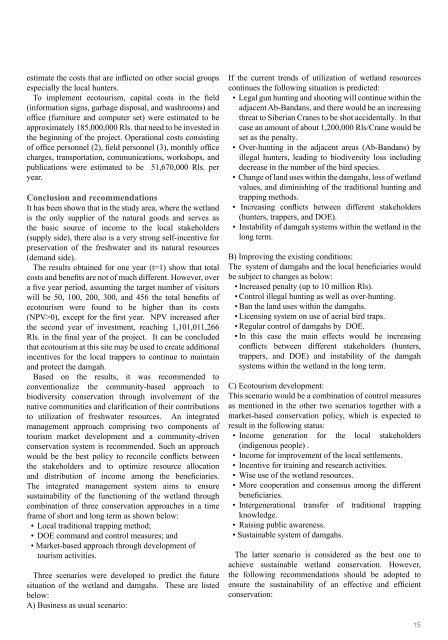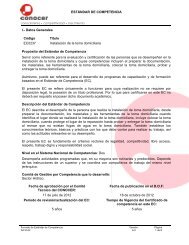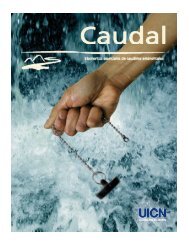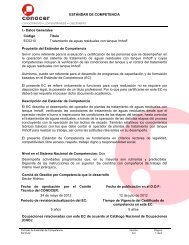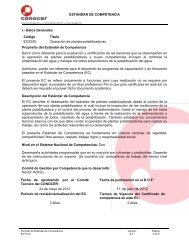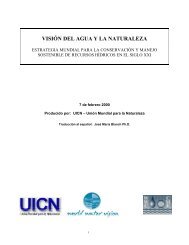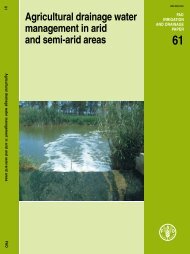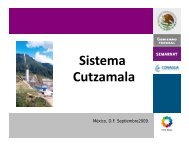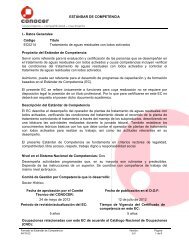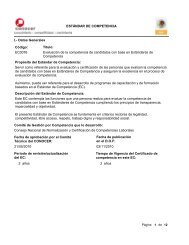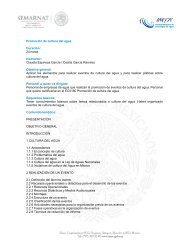The Conservation and Sustainable Use of Freshwater ... - IUCN
The Conservation and Sustainable Use of Freshwater ... - IUCN
The Conservation and Sustainable Use of Freshwater ... - IUCN
Create successful ePaper yourself
Turn your PDF publications into a flip-book with our unique Google optimized e-Paper software.
estimate the costs that are inflicted on other social groups<br />
especially the local hunters.<br />
To implement ecotourism, capital costs in the field<br />
(information signs, garbage disposal, <strong>and</strong> washrooms) <strong>and</strong><br />
<strong>of</strong>fice (furniture <strong>and</strong> computer set) were estimated to be<br />
approximately 185,000,000 Rls. that need to be invested in<br />
the beginning <strong>of</strong> the project. Operational costs consisting<br />
<strong>of</strong> <strong>of</strong>fice personnel (2), field personnel (3), monthly <strong>of</strong>fice<br />
charges, transportation, communications, workshops, <strong>and</strong><br />
publications were estimated to be 51,670,000 Rls. per<br />
year.<br />
Conclusion <strong>and</strong> recommendations<br />
It has been shown that in the study area, where the wetl<strong>and</strong><br />
is the only supplier <strong>of</strong> the natural goods <strong>and</strong> serves as<br />
the basic source <strong>of</strong> income to the local stakeholders<br />
(supply side), there also is a very strong self-incentive for<br />
preservation <strong>of</strong> the freshwater <strong>and</strong> its natural resources<br />
(dem<strong>and</strong> side).<br />
<strong>The</strong> results obtained for one year (t=1) show that total<br />
costs <strong>and</strong> benefits are not <strong>of</strong> much different. However, over<br />
a five year period, assuming the target number <strong>of</strong> visitors<br />
will be 50, 100, 200, 300, <strong>and</strong> 456 the total benefits <strong>of</strong><br />
ecotourism were found to be higher than its costs<br />
(NPV>0), except for the first year. NPV increased after<br />
the second year <strong>of</strong> investment, reaching 1,101,011,266<br />
Rls. in the final year <strong>of</strong> the project. It can be concluded<br />
that ecotourism at this site may be used to create additional<br />
incentives for the local trappers to continue to maintain<br />
<strong>and</strong> protect the damgah.<br />
Based on the results, it was recommended to<br />
conventionalize the community-based approach to<br />
biodiversity conservation through involvement <strong>of</strong> the<br />
native communities <strong>and</strong> clarification <strong>of</strong> their contributions<br />
to utilization <strong>of</strong> freshwater resources. An integrated<br />
management approach comprising two components <strong>of</strong><br />
tourism market development <strong>and</strong> a community-driven<br />
conservation system is recommended. Such an approach<br />
would be the best policy to reconcile conflicts between<br />
the stakeholders <strong>and</strong> to optimize resource allocation<br />
<strong>and</strong> distribution <strong>of</strong> income among the beneficiaries.<br />
<strong>The</strong> integrated management system aims to ensure<br />
sustainability <strong>of</strong> the functioning <strong>of</strong> the wetl<strong>and</strong> through<br />
combination <strong>of</strong> three conservation approaches in a time<br />
frame <strong>of</strong> short <strong>and</strong> long term as shown below:<br />
• Local traditional trapping method;<br />
• DOE comm<strong>and</strong> <strong>and</strong> control measures; <strong>and</strong><br />
• Market-based approach through development <strong>of</strong><br />
tourism activities.<br />
Three scenarios were developed to predict the future<br />
situation <strong>of</strong> the wetl<strong>and</strong> <strong>and</strong> damgahs. <strong>The</strong>se are listed<br />
below:<br />
A) Business as usual scenario:<br />
If the current trends <strong>of</strong> utilization <strong>of</strong> wetl<strong>and</strong> resources<br />
continues the following situation is predicted:<br />
• Legal gun hunting <strong>and</strong> shooting will continue within the<br />
adjacent Ab-B<strong>and</strong>ans, <strong>and</strong> there would be an increasing<br />
threat to Siberian Cranes to be shot accidentally. In that<br />
case an amount <strong>of</strong> about 1,200,000 Rls/Crane would be<br />
set as the penalty.<br />
• Over-hunting in the adjacent areas (Ab-B<strong>and</strong>ans) by<br />
illegal hunters, leading to biodiversity loss including<br />
decrease in the number <strong>of</strong> the bird species.<br />
• Change <strong>of</strong> l<strong>and</strong> uses within the damgahs, loss <strong>of</strong> wetl<strong>and</strong><br />
values, <strong>and</strong> diminishing <strong>of</strong> the traditional hunting <strong>and</strong><br />
trapping methods.<br />
• Increasing conflicts between different stakeholders<br />
(hunters, trappers, <strong>and</strong> DOE).<br />
• Instability <strong>of</strong> damgah systems within the wetl<strong>and</strong> in the<br />
long term.<br />
B) Improving the existing conditions:<br />
<strong>The</strong> system <strong>of</strong> damgahs <strong>and</strong> the local beneficiaries would<br />
be subject to changes as below:<br />
• Increased penalty (up to 10 million Rls).<br />
• Control illegal hunting as well as over-hunting.<br />
• Ban the l<strong>and</strong> uses within the damgahs.<br />
• Licensing system on use <strong>of</strong> aerial bird traps.<br />
• Regular control <strong>of</strong> damgahs by DOE.<br />
• In this case the main effects would be increasing<br />
conflicts between different stakeholders (hunters,<br />
trappers, <strong>and</strong> DOE) <strong>and</strong> instability <strong>of</strong> the damgah<br />
systems within the wetl<strong>and</strong> in the long term.<br />
C) Ecotourism development:<br />
This scenario would be a combination <strong>of</strong> control measures<br />
as mentioned in the other two scenarios together with a<br />
market-based conservation policy, which is expected to<br />
result in the following status:<br />
• Income generation for the local stakeholders<br />
(indigenous people) .<br />
• Income for improvement <strong>of</strong> the local settlements.<br />
• Incentive for training <strong>and</strong> research activities.<br />
• Wise use <strong>of</strong> the wetl<strong>and</strong> resources.<br />
• More cooperation <strong>and</strong> consensus among the different<br />
beneficiaries.<br />
• Intergenerational transfer <strong>of</strong> traditional trapping<br />
knowledge.<br />
• Raising public awareness.<br />
• <strong>Sustainable</strong> system <strong>of</strong> damgahs.<br />
<strong>The</strong> latter scenario is considered as the best one to<br />
achieve sustainable wetl<strong>and</strong> conservation. However,<br />
the following recommendations should be adopted to<br />
ensure the sustainability <strong>of</strong> an effective <strong>and</strong> efficient<br />
conservation:<br />
15


